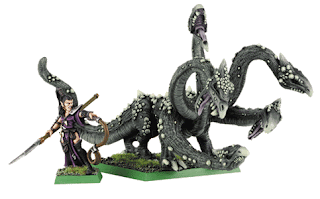I've been thinking a lot recently about what my ideal collection of models would look like (if money time etc were no object). A complete army perhaps? Played on a table with nice scenery? Hmm, yes. That goes without saying. But of course, my mind wanders and I start wanting more. Much more. Until the only thing that will satisfy me is TOTAL WAR(hammer).
Total what?
It all starts with a bunch of friends. Like most people, I have two distinct groups of friends:
Group 1: old friends I've known for years
Group 2: whichever guys I happen to be friends with in my current job/location
In years previous, Group 2 has always been totally against my hobby, and I'm used to keeping it under wraps. It's only by a stroke of luck that currently Group 2 are all into wargaming. If ever I move to a different city or job, I can well imagine going back to never mentioning it to the group for fear of utter ridicule and rejection.
Group 1 on the other hand have only ever really dabbled in gaming (though never collecting miniatures) and have politely humoured me over the years by indulging my hobby when we meet. They're not really into it, and so I never push hard, or expect any sacrifice or expenditure on their part. The way I see it is that if I want them to play a game with me, I should provide all the models (and nibbles) and make the whole experience as enjoyable for them as possible. Call it a wargaming reacharound.
Perversely, I prefer playing with the inexperienced Group 1 friends than the seasoned gamers of Group 2. Seasoned gamers are quite used to bashing and clattering their models around and using scratty bits of makeshift scenery. They don't understand why I spend so long carefully taking each model from its case or why I insist on using a GW measuring stick instead of a B&Q tape measure. They don't understand why I get so p*ssed off when they represent their Lord-level killing machine with a rank-and-file model (something you only discover when you charge it) or why their spearmen with a bit of blu-tac on his spear-tip turns out to be an army standard bearer.
Non-players are far more respectful of your models, and they instinctively dislike "count as" proxies. When you tell them "that guy is your wizard" they get a little look of excitement on their faces and carefully examine the model, hoping to see some particularly characterful model in a pointy hat. They don't want to hear "just pretend that spearman is your wizard" or "we won't bother with a river because I haven't got one". If they're going to invest their time in a game, they want to know there's plenty of awesomeness on the table, and I'm going to have to provide it all for them.
So unlike a lot of gamers, I simply can't focus on collecting one army. Indeed, I insist on having more than one. What if, say, I invite a Group 1 friend over and suggest a game of warhammer? I would then have to produce an army for me to use and one for him to use. Since he doesn't know much about the Warhammer universe, I'd want to offer him an army that would appeal to him, and since he's unfamiliar with the game, I'd want the two armies to interact well with each other and contrast nicely in their styles of play and their presence on the table. And since it might be the only game of warhammer they will ever play, I'd want it to knock their socks off - look amazing, play well, have cool and interesting things going on. I would want to produce out of a hat the sort of demonstration gaming experience that most gaming clubs work hard to put on during a gaming convention.
So in a sense, total warhammer is the perfect demo game: it looks impressive, you get a real sense of the warhammer universe and you feel immersed in the experience. All gamers, old and new, should be seduced by it and want to play.
So rule number 1 of total warhammer is:
1. Everything should be awesome.
One paintjob to bind them
Let's face it, I'm only ever going to get the opportunity to play this magical demo game about five times in my life. But a nice side effect is that I won't have to compromise - everything involved in the game will be created by me.
I'll be honest, it's very rare that I play against an army that I think looks cool. Mostly, the models come out and I politely go through the ritual of saying "hey, nice paintjob, bro!". But invariably it's not really a nice paintjob; its a gloopy mess of thick drybrushing in ugly colours. And that's assuming they're painted at all. So no matter how good you think your army looks, the game as a whole looks rubbish.
Having to produce more than one army gives me a chance to model and paint opposing armies in the same style, with visual and narrative links to each other.
For instance, you could give every army in the collection the same type of base, and those bases could be painted to match the surface of the battlefield, so a rock on an empire soldier's base is painted the same way as the rocky scenery he's standing on, and the same as the rocks used in the orc rocklobber that's aiming at him. Extend that further and you could adorn the models with trophies from other armies - Grimgor holds up a severed head that is painted in exactly the same way as the empire knights he's fighting.
Further still and the buildings and scenery could be themed towards the two armies, with matching iconography and decoration, so a charnel pit is filled with bodies dressed in the same livery as the soldiers standing next to them; the mushrooms growing in a fungus forest look like the same fungus a goblin shaman is munching on and that are growing all over the orc-themed buildings.
Potentially you've got something that is visually unified and immersive; something that only Warhammer Online has managed to do so far.
So rule number two of total warhammer is:
2. Everything should be part of a shared, strong, visual aesthetic.
What's the story?
A really important aspect in achieving this immersive experience is a sense of narrative realism. We all know how weird and wacky it is to roll up randomly generated terrain and find that someone has decided to build their farmhouse next to an ancient temple of evil that gobs out fireballs at them whenever they walk past to milk the cows.
Similarly, I've never been a big fan of Lizardmen and Tomb Kings. Not because of the army background or models (both are great) but because in the Olde World they exist on a separate continent. Broadly speaking, warhammer is "set" in the Empire (though you could set it somewhere else). So having a bunch of skeletons rising from desert sands and egyptian-style pyramids seems totally out of place. Sure, you can give them a back-story that explains why they're on tour, but half the fun of a well-painted lizardman army is all the jungle vegitation adorning their bases - you're telling me they bring their jungle plants with them?
For me you have to believe that the corner of the warhammer world portrayed by your gaming table could actually exist, and that the armies marching around there are there for a reason.
Rule number three therefore is:
3. Nothing should exist outside a believable, coherent narrative.
Invisible fireballs
One of the greatest things about computer games set in the warhammer universe is being able to see magic effects. It's a huge area of the game, and yet on the tabletop is belongs purely in your imagination. Wouldn't it be great to have magic modelled into the game - real, tangible, colourful magic.
In fact there are all sorts of things we use in warhammer that we don't expect to have to model - explosions, casualties, troops occupying buildings. Not to mention the mechanical tools of the game - dice, movement trays, templates, wound markers etc, that with a little modelling and painting could keep your disbelief in suspension. How often have you placed a dice next to a model to represented wounds, only to pick it up by accident later on and roll it?
Now, GW have done much in the last few years to correct this. We have themed resin dice, engineer's templates and rulers, Battle for Skull Pass wound markers, but it's still an area of the game that remains largely untapped.
Rule number four is:
4. Everything counts, not just the models.
The spirit of the Workshop
Lastly, there's the issue of customisation. GW's intellectual property is what has made the game so successful - no other game can match it in the long-established, rich and detailed universe it has created.
So it would be dumb to throw all that away. I know a lot of people get a blast out of mashing up GW stuff for comic effect (samurai orcs, teddy bear tyranids etc) but it's not my bag. I see it as a responsibility to best represent the world and mythos that GW have established. And in a collection that includes many armies, each one should demonstrate its unique character as defined by GW. So an orc army should be uniquely orcy. And a high elf army should be uniquely high elfy.
However, there's a rich tradition in the modelling community of giving your models a twist - something original; something that identifies it as belonging to you. It's as if you take an imaginary seat at the table of GW designers, modellers and painters and make your own contribution to the genre.
Now, I happen to believe that GW actually get it wrong sometimes. There are plenty of examples of models that seem to fall short of their own high standards, or don't fit with the vision described in their accompanying descriptions, or seem incongruous with the rest of the army. I always want to fix that.
I want my collection to walk that line: to best demonstrate GW's ideas and continuity directly as GW intend it, while presenting something original and unique. And in doing so, I'll try and fix a few things too.
For that reason I'm going to stick to GW-only models in their most up-to-date incarnations as much as I can, but include modifications to some core designs. I'll break with GW convention, but only where I feel it still fits the spirit of what GW intended.
So as toadying as this sounds (especially given the amount of money we pay them), my last rule of total warhammer is:
5. Respect Games Workshop.
So there are my rules. Don't be surprised if in my project logs I refer to them occasionally (it saves explaining all that again).
If I stick to the rules of Total Warhammer, I might just end up with the collection of my dreams.
Then I'll be forced to kill myself, knowing that never again would I achieve such perfection.












